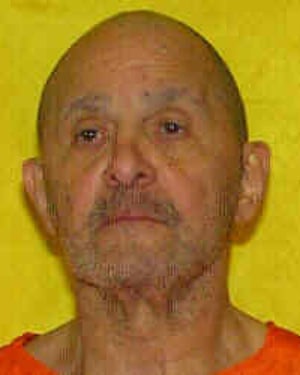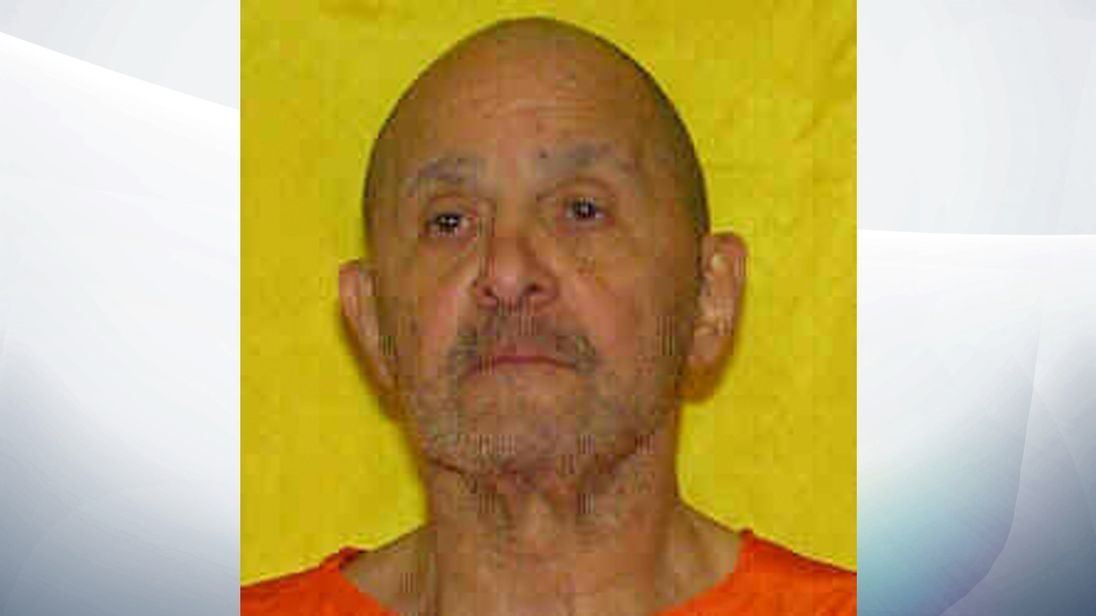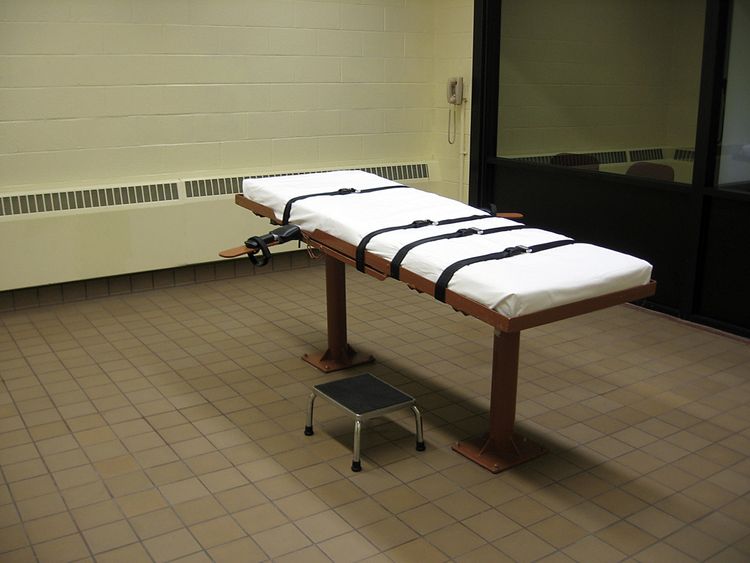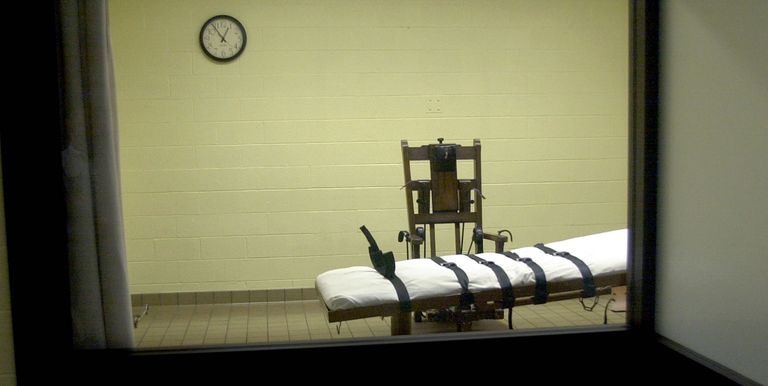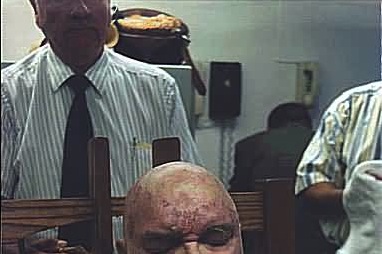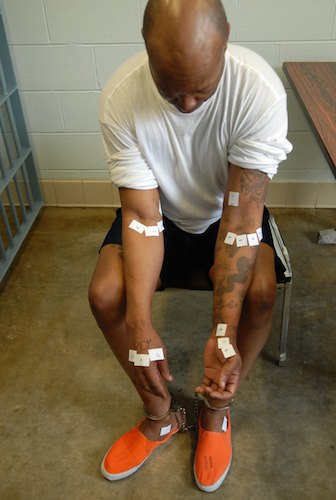https://deathpenaltyinfo.org/some-examples-post-furman-botched-executions
Botched Executions
It is estimated that 3% of U.S. executions in the period from 1890 to 2010 were botched. In the 2014 book,
Gruesome Spectacles: Botched Executions and America's Death Penalty, Austin Sarat, a professor of jurisprudence and political science at Amherst College, describes the history of flawed executions in the U.S. during that period. He reports that over those 120 years, 8,776 people were executed and 276 of those executions (3.15%) went wrong in some way. Lethal injection had the highest rate of botched executions.
Method Total Executions Botched Executions Botched Execution Rate
Hanging 2,721 85 3.12%
Electrocution 4,374 84 1.92%
Lethal Gas 593 32 5.4%
Lethal Injection 1,054 75 7.12%
Firing Squad 34 0 0%
All Methods 8,776 276 3.15%
Source:
Gruesome Spectacles
Sarat describes the evolution of new methods of execution and the rhetoric advanced to support changes from one method to another: "With each development in the technology of execution, the same promises have been made, that each new technology was safe, reliable, effective and humane. Those claims have not generally been fulfilled."
Austin Sarat, "
Gruesome Spectacles: Botched Executions and America's Death Penalty" (Stanford Univ. Press 2014).
A report in the
Salt Lake City Tribune takes a different view of the suggestion that there have been no botched executions by firing squad since 1890. The paper reports that in September 1951, a Utah firing squad shot Eliseo J. Mares in the hip and abdomen and that it was "several minutes" before he was declared dead. Utah's May 16, 1879 firing-squad execution of Wallace Wilkerson also was botched. See
Botched Executions in American History.
Examples of Post-Furman Botched Executions
List compiled by:
Prof. Michael L. Radelet
University of Colorado
[email protected]
With updates from DPIC. Last addition: November 15, 2017
NOTE: The cases below are not presented as a comprehensive catalogue of all botched executions, but simply a listing of examples that are well-known. There are 50 executions listed: 2 by asphyxiation, 10 by electrocution, and 36 by lethal injection, and 2 attempted execution by lethal injection.
1. August 10, 1982. Virginia.
Frank J. Coppola. Electrocution. Although no media representatives witnessed the execution and no details were ever released by the Virginia Department of Corrections, an attorney who was present later stated that it took two 55-second jolts of electricity to kill Coppola. The second jolt produced the odor and sizzling sound of burning flesh, and Coppola's head and leg caught on fire. Smoke filled the death chamber from floor to ceiling with a smoky haze.
[1]
2. April 22, 1983. Alabama.
John Evans. Electrocution. After the first jolt of electricity, sparks and flames erupted from the electrode attached to Evans's leg. The electrode burst from the strap holding it in place and caught on fire. Smoke and sparks also came out from under the hood in the vicinity of Evans's left temple. Two physicians entered the chamber and found a heartbeat. The electrode was reattached to his leg, and another jolt of electricity was applied. This resulted in more smoke and burning flesh. Again the doctors found a heartbeat. Ignoring the pleas of Evans's lawyer, a third jolt of electricity was applied. The execution took 14 minutes and left Evans's body charred and smoldering.
[2]
3. Sept. 2, 1983. Mississippi.
Jimmy Lee Gray. Asphyxiation. Officials had to clear the room eight minutes after the gas was released when Gray's desperate gasps for air repulsed witnesses. His attorney, Dennis Balske of Montgomery, Alabama, criticized state officials for clearing the room when the inmate was still alive. Said noted death penalty defense attorney David Bruck, "Jimmy Lee Gray died banging his head against a steel pole in the gas chamber while the reporters counted his moans (eleven, according to the Associated Press)."
[3] Later it was revealed that the executioner, Barry Bruce, was drunk.
[4]
4. December 12, 1984. Georgia.
Alpha Otis Stephens. Electrocution. "The first charge of electricity … failed to kill him, and he struggled to breathe for eight minutes before a second charge carried out his death sentence …"
[5] After the first two minute power surge, there was a six minute pause so his body could cool before physicians could examine him (and declare that another jolt was needed). During that six-minute interval, Stephens took 23 breaths. A Georgia prison official said, "Stephens was just not a conductor" of electricity.
[6]
5. March 13, 1985. Texas.
Stephen Peter Morin. Lethal Injection. The Associated Press reported that, because of Morin's history of drug abuse, the execution technicians were forced to probe both of Morin's arms and one of his legs with needles for nearly 45 minutes before they found a suitable vein.
[7]
6. October 16, 1985. Indiana.
William E. Vandiver. Electrocution. After the first administration of 2,300 volts, Vandiver was still breathing. The execution eventually took 17 minutes and five jolts of electricity.
[8] Vandiver's attorney, Herbert Shaps, witnessed the execution and observed smoke and the smell of burning. He called the execution "outrageous." The Department of Corrections admitted the execution "did not go according to plan."
[9]
7. August 20, 1986. Texas.
Randy Woolls. Lethal Injection. A drug addict, Woolls helped the execution technicians find a useable vein for the execution.
[10]
8. June 24, 1987. Texas.
Elliot Rod Johnson. Lethal Injection. Because of collapsed veins, it took nearly an hour to complete the execution.
[11]
9. December 13, 1988. Texas.
Raymond Landry. Lethal Injection. Pronounced dead 40 minutes after being strapped to the execution gurney and 24 minutes after the drugs first started flowing into his arms.
[12] Two minutes after the drugs were administered, the syringe came out of Landry's vein, spraying the deadly chemicals across the room toward witnesses. The curtain separating the witnesses from the inmate was then pulled, and not reopened for fourteen minutes while the execution team reinserted the catheter into the vein. Witnesses reported "at least one groan." A spokesman for the Texas Department of Correction, Charles Brown (sic), said, "There was something of a delay in the execution because of what officials called a 'blowout.' The syringe came out of the vein, and the warden ordered the (execution) team to reinsert the catheter into the vein."
[13]
10. May 24, 1989. Texas.
Stephen McCoy. Lethal Injection. He had such a violent physical reaction to the drugs (heaving chest, gasping, choking, back arching off the gurney, etc.) that one of the witnesses (male) fainted, crashing into and knocking over another witness. Houston attorney Karen Zellars, who represented McCoy and witnessed the execution, thought the fainting would catalyze a chain reaction. The Texas Attorney General admitted the inmate "seemed to have had a somewhat stronger reaction," adding, "The drugs might have been administered in a heavier dose or more rapidly."
[14]
11. July 14, 1989. Alabama.
Horace Franklin Dunkins, Jr. Electrocution. It took two jolts of electricity, nine minutes apart, to complete the execution. After the first jolt failed to kill the prisoner (who was mildly retarded), the captain of the prison guard opened the door to the witness room and stated "I believe we've got the jacks on wrong."
[15] Because the cables had been connected improperly, it was impossible to dispense sufficient current to cause death. The cables were reconnected before a second jolt was administered. Death was pronounced 19 minutes after the first electric charge. At a post-execution news conference, Alabama Prison Commissioner Morris Thigpen said, “I regret very very much what happened. [The cause] was human error."
[16]
12. May 4, 1990. Florida. J
esse Joseph Tafero. Electrocution. During the execution, six-inch flames erupted from Tafero's head, and three jolts of power were required to stop his breathing. State officials claimed that the botched execution was caused by "inadvertent human error" — the inappropriate substitution of a synthetic sponge for a natural sponge that had been used in previous executions.
[17] They attempted to support this theory by sticking a part of a synthetic sponge into a "common household toaster" and observing that it smoldered and caught fire.
[18]
13. September 12, 1990. Illinois.
Charles Walker. Lethal Injection. Because of equipment failure and human error, Walker suffered excruciating pain during his execution. According to Gary Sutterfield, an engineer from the Missouri State Prison who was retained by the State of Illinois to assist with Walker's execution, a kink in the plastic tubing going into Walker's arm stopped the deadly chemicals from reaching Walker. In addition, the intravenous needle was inserted pointing at Walker's fingers instead of his heart, prolonging the execution.
[19]
14. October 17, 1990. Virginia.
Wilbert Lee Evans. Electrocution. When Evans was hit with the first burst of electricity, blood spewed from the right side of the mask on Evans's face, drenching Evans's shirt with blood and causing a sizzling sound as blood dripped from his lips. Evans continued to moan before a second jolt of electricity was applied. The autopsy concluded that Evans suffered a bloody nose after the voltage surge elevated his high blood pressure.
[20]
15. August 22, 1991. Virginia.
Derick Lynn Peterson. Electrocution. After the first cycle of electricity was applied, and again four minutes later, prison physician David Barnes inspected Peterson's neck and checked him with a stethoscope, announcing each time "He has not expired." Seven and one-half minutes after the first attempt to kill the inmate, a second cycle of electricity was applied. Prison officials later announced that in the future they would routinely administer two cycles before checking for a heartbeat.
[21]
16. January 24, 1992. Arkansas.
Rickey Ray Rector. Lethal Injection. It took medical staff more than 50 minutes to find a suitable vein in Rector's arm. Witnesses were kept behind a drawn curtain and not permitted to view this scene, but reported hearing Rector's eight loud moans throughout the process. During the ordeal Rector (who suffered from serious brain damage) helped the medical personnel find a vein. The administrator of State's Department of Corrections medical programs said (paraphrased by a newspaper reporter) "the moans did come as a team of two medical people that had grown to five worked on both sides of his body to find a vein." The administrator said "That may have contributed to his occasional outbursts." The difficulty in finding a suitable vein was later attributed to Rector's bulk and his regular use of antipsychotic medication.
[22]
17. April 6, 1992. Arizona.
Donald Eugene Harding. Asphyxiation. Death was not pronounced until 10 1/2 minutes after the cyanide tablets were dropped.
[23] During the execution, Harding thrashed and struggled violently against the restraining straps. A television journalist who witnessed the execution, Cameron Harper, said that Harding's spasms and jerks lasted 6 minutes and 37 seconds. "Obviously, this man was suffering. This was a violent death … an ugly event. We put animals to death more humanely."
[24] Another witness, newspaper reporter Carla McClain, said, "Harding's death was extremely violent. He was in great pain. I heard him gasp and moan. I saw his body turn from red to purple."
[25] One reporter who witnessed the execution suffered from insomnia and assorted illnesses for several weeks; two others were "walking vegetables" for several days.
[26]
18. March 10, 1992. Oklahoma.
Robyn Lee Parks. Lethal Injection. Parks had a violent reaction to the drugs used in the lethal injection. Two minutes after the drugs were dispensed, the muscles in his jaw, neck, and abdomen began to react spasmodically for approximately 45 seconds. Parks continued to gasp and violently gag until death came, some eleven minutes after the drugs were first administered. Tulsa World reporter Wayne Greene wrote that the execution looked "painful," "scary and ugly." "It was overwhelming, stunning, disturbing — an intrusion into a moment so personal that reporters, taught for years that intrusion is their business, had trouble looking each other in the eyes after it was over."
[27]
19. April 23, 1992. Texas.
Billy Wayne White. Lethal Injection. White was pronounced dead some 47 minutes after being strapped to the execution gurney. The delay was caused by difficulty finding a vein; White had a long history of heroin abuse. During the execution, White attempted to assist the authorities in finding a suitable vein.
[28]
20. May 7, 1992. Texas.
Justin Lee May. Lethal Injection. May had an unusually violent reaction to the lethal drugs. According to one reporter who witnessed the execution, May "gasped, coughed and reared against his heavy leather restraints, coughing once again before his body froze .…"
[29] Associated Press reporter Michael Graczyk wrote, "Compared to other recent executions in Texas, May's reaction to the drugs was more violent. He went into a coughing spasm, groaned and gasped, lifted his head from the death chamber gurney and would have arched his back if he had not been belted down. After he stopped breathing, his eyes and mouth remained open."
[30]
21. May 10, 1994. Illinois.
John Wayne Gacy. Lethal Injection. After the execution began, the lethal chemicals unexpectedly solidified, clogging the IV tube that led into Gacy's arm, and prohibiting any further passage. Blinds covering the window through which witnesses observed the execution were drawn, and the execution team replaced the clogged tube with a new one. Ten minutes later, the blinds were then reopened and the execution process resumed. It took 18 minutes to complete.
[31] Anesthesiologists blamed the problem on the inexperience of prison officials who were conducting the execution, saying that proper procedures taught in "IV 101" would have prevented the error.
[32]
22. May 3, 1995. Missouri.
Emmitt Foster. Lethal Injection. Seven minutes after the lethal chemicals began to flow into Foster's arm, the execution was halted when the chemicals stopped circulating. With Foster gasping and convulsing, the blinds were drawn so the witnesses could not view the scene. Death was pronounced thirty minutes after the execution began, and three minutes later the blinds were reopened so the witnesses could view the corpse.
[33] According to William "Mal" Gum, the Washington County Coroner who pronounced death, the problem was caused by the tightness of the leather straps that bound Foster to the execution gurney; it was so tight that the flow of chemicals into the veins was restricted. Foster did not die until several minutes after a prison worker finally loosened the straps. The coroner entered the death chamber twenty minutes after the execution began, diagnosed the problem, and told the officials to loosen the strap so the execution could proceed.
[34] In an editorial, the St. Louis Post-Dispatch called the execution "a particularly sordid chapter in Missouri's capital punishment experience."
[35]
23. January 23, 1996. Virginia.
Richard Townes, Jr. Lethal Injection. This execution was delayed for 22 minutes while medical personnel struggled to find a vein large enough for the needle. After unsuccessful attempts to insert the needle through the arms, the needle was finally inserted through the top of Mr. Townes's right foot.
[36]
24. July 18, 1996. Indiana.
Tommie J. Smith. Lethal Injection. Because of unusually small veins, it took one hour and nine minutes for Smith to be pronounced dead after the execution team began sticking needles into his body. For sixteen minutes, the execution team failed to find adequate veins, and then a physician was called.
[37] Smith was given a local anesthetic and the physician twice attempted to insert the tube in Smith's neck. When that failed, an angio-catheter was inserted in Smith's foot. Only then were witnesses permitted to view the process. The lethal drugs were finally injected into Smith 49 minutes after the first attempts, and it took another 20 minutes before death was pronounced.
[38]
25. March 25, 1997. Florida.
Pedro Medina. Electrocution. A crown of foot-high flames shot from the headpiece during the execution, filling the execution chamber with a stench of thick smoke and gagging the two dozen official witnesses. An official then threw a switch to manually cut off the power and prematurely end the two-minute cycle of 2,000 volts. Medina's chest continued to heave until the flames stopped and death came.
[39] After the execution, prison officials blamed the fire on a corroded copper screen in the headpiece of the electric chair, but two experts hired by the governor later concluded that the fire was caused by the improper application of a sponge (designed to conduct electricity) to Medina's head.
26. May 8, 1997. Oklahoma.
Scott Dawn Carpenter. Lethal Injection. Carpenter was pronounced dead some 11 minutes after the lethal injection was administered. As the drugs took effect, Carpenter began to gasp and shake. "This was followed by a guttural sound, multiple spasms and gasping for air" until his body stopped moving, three minutes later.
[40]
27. June 13, 1997. South Carolina.
Michael Eugene Elkins. Lethal Injection. Because Elkins's body had become swollen from liver and spleen problems, it took nearly an hour to find a suitable vein for the insertion of the catheter. Elkins tried to assist the executioners, asking "Should I lean my head down a little bit?" as they probed for a vein. After numerous failures, a usable vein was finally found in Elkins's neck.
[41]
28. April 23, 1998. Texas.
Joseph Cannon. Lethal Injection. It took two attempts to complete the execution. After making his final statement, the execution process began. A vein in Cannon's arm collapsed and the needle popped out. Seeing this, Cannon lay back, closed his eyes, and exclaimed to the witnesses, "It's come undone." Officials then pulled a curtain to block the view of the witnesses, reopening it fifteen minutes later when a weeping Cannon made a second final statement and the execution process resumed.
[42]
29. August 26, 1998. Texas.
Genaro Ruiz Camacho. Lethal Injection. The execution was delayed approximately two hours due, in part, to problems finding suitable veins in Camacho's arms.
[43]
30. October 5, 1998. Nevada.
Roderick Abeyta. Lethal Injection. It took 25 minutes for the execution team to find a vein suitable for the lethal injection.
[44]
31. July 8, 1999. Florida.
Allen Lee Davis. Electrocution. "Before he was pronounced dead … the blood from his mouth had poured onto the collar of his white shirt, and the blood on his chest had spread to about the size of a dinner plate, even oozing through the buckle holes on the leather chest strap holding him to the chair."
[45] His execution was the first in Florida's new electric chair, built especially so it could accommodate a man Davis's size (approximately 350 pounds). Later, when another Florida death row inmate challenged the constitutionality of the electric chair, Florida Supreme Court Justice Leander Shaw commented that "the color photos of Davis depict a man who — for all appearances — was brutally tortured to death by the citizens of Florida."
[46] Justice Shaw also described the botched executions of Jesse Tafero and Pedro Medina (q.v.), calling the three executions "barbaric spectacles" and "acts more befitting a violent murderer than a civilized state."
[47] Justice Shaw included pictures of Davis's dead body in his opinion.
[48] The execution was witnessed by a Florida State Senator, Ginny Brown-Waite, who at first was "shocked" to see the blood, until she realized that the blood was forming the shape of a cross and that it was a message from God saying he supported the execution.
[49] (See
Photos taken after execution—graphic images).
32. May 3, 2000. Arkansas.
Christina Marie Riggs. Lethal Injection. Riggs dropped her appeals and asked to be executed. However, the execution was delayed for 18 minutes when prison staff couldn't find a suitable vein in her elbows. Finally, Riggs agreed to the executioners' requests to have the needles in her wrists.
[50]
33. June 8, 2000. Florida.
Bennie Demps. Lethal Injection. It took execution technicians 33 minutes to find suitable veins for the execution. "They butchered me back there," said Demps in his final statement. "I was in a lot of pain. They cut me in the groin; they cut me in the leg. I was bleeding profusely. This is not an execution, it is murder." The executioners had no unusual problems finding one vein, but because Florida protocol requires a second alternate intravenous drip, they continued to work to insert another needle, finally abandoning the effort after their prolonged failures.
[51]
34. December 7, 2000. Texas.
Claude Jones. Lethal Injection. Jones was a former intravenous drug abuser. His execution was delayed 30 minutes while the execution team struggled to insert an IV into a vein. One member of the execution team commented, "They had to stick him about five times. They finally put it in his leg." Jim Willett, the warden of the Walls Unit and the man responsible for conducting the execution, wrote: "The medical team could not find a vein. Now I was really beginning to worry. If you can't stick a vein then a cut-down has to be performed. I have never seen one and would just as soon go through the rest of my career the same way. Just when I was really getting worried, one of the medical people hit a vein in the left leg. Inside calf to be exact. The executioner had warned me not to panic as it was going to take a while to get the fluids in the body of the inmate tonight because he was going to push the drugs through very slowly. Finally, the drug took effect and Jones took his last breath."
[52]
35. June 28, 2000. Missouri.
Bert Leroy Hunter. Lethal Injection. Hunter had an unusual reaction to the lethal drugs, repeatedly coughing and gasping for air before he lapsed into unconsciousness.
[53] An attorney who witnessed the execution reported that Hunter had "violent convulsions. His head and chest jerked rapidly upward as far as the gurney restraints would allow, and then he fell quickly down upon the gurney. His body convulsed back and forth like this repeatedly. … He suffered a violent and agonizing death."
[54] However, three reporters who witnessed the execution did not substantiate these observations, with two reporting that Hunter simply coughed several times and the third stating that he saw no violent reaction to the drugs.
[55]
36. November 7, 2001. Georgia.
Jose High. Lethal Injection. High was pronounced dead some one hour and nine minutes after the execution began. After attempting to find a useable vein for "15 to 20 minutes," the emergency medical technicians under contract to do the execution abandoned their efforts. Eventually, one needle was stuck in High's hand, and a physician was called in to insert a second needle between his shoulder and neck.
[56]
37. May 2, 2006. Ohio.
Joseph L. Clark. Lethal Injection. It took 22 minutes for the execution technicians to find a vein suitable for insertion of the catheter. But three or four minutes thereafter, as the vein collapsed and Clark’s arm began to swell, he raised his head off the gurney and said five times, “It don’t work. It don’t work.” The curtains surrounding the gurney were then closed while the technicians worked for 30 minutes to find another vein. Media witnesses later reported that they heard “moaning, crying out and guttural noises.”
[57] Finally, death was pronounced almost 90 minutes after the execution began. A spokeswoman for the Ohio Department of Corrections told reporters that the execution team included paramedics, but not a physician or a nurse.
[58]
38. December 13, 2006. Florida.
Angel Diaz. Lethal Injection. After the first injection was administered, Mr. Diaz continued to move, and was squinting and grimacing as he tried to mouth words. A second dose was then administered, and 34 minutes passed before Mr. Diaz was declared dead. At first a spokesperson for the Florida Department of Corrections claimed that this was because Mr. Diaz had some sort of liver disease.
[59] After performing an autopsy, the Medical Examiner, Dr. William Hamilton, stated that Mr. Diaz’s liver was undamaged, but that the IV catheters (which had been inserted in both arms) had gone through Mr. Diaz’s veins and out the other side, so the deadly chemicals were injected into soft tissue, rather than the vein. Two days after the execution, Governor Jeb Bush temporarily suspended all executions in the state and appointed a commission “to consider the humanity and constitutionality of lethal injections.”
[60] In 2014,
pictures from the autopsy of Mr. Diaz’s body, along with a long article describing his painful death, were published in THE NEW REPUBLIC.
[61]
39. May 24, 2007. Ohio.
Christopher Newton. Lethal Injection. According to the Associated Press, “prison medical staff” at the Southern Ohio Correctional Facility struggled to find veins on each of Newton’s arms during the execution. Newton, who weighted 265 pounds, was declared dead almost two hours after the execution process began. The execution “team” stuck Newton at least ten times with needles before getting the shunts in place were the needles are injected.
[62]
40. June 26, 2007. Georgia.
John Hightower. Lethal Injection. It took approximately 40 minutes for the nurses to find a suitable vein to administer the lethal chemicals, and death was not pronounced until 7:59, 59 minutes after the execution process began.
[63]
41. June 4, 2008. Georgia.
Curtis Osborne. Lethal Injection. After a 55-minute delay while the U.S. Supreme Court reviewed his final appeal, prison medical staff began the execution by trying to find suitable veins in which to insert the IV. The executioners struggled for 35 minutes to find a vein, and it took 14 minutes after the fatal drugs were administered before death was pronounced by two physicians who were inside the death chamber.
[64]
42. Sept. 15, 2009. Ohio.
Romell Broom (pictured, after execution attempt). Attempted Lethal Injection. Efforts to find a suitable vein and to execute Mr. Broom were terminated after more than two hours when the executioners were unable to find a useable vein in Mr. Broom’s arms or legs. During the failed efforts, Mr. Broom winced and grimaced with pain. After the first hour’s lack of success, on several occasions Broom tried to help the executioners find a good vein. “At one point, he covered his face with both hands and appeared to be sobbing, his stomach heaving.
[65] Finally, Ohio Governor Ted Strickland ordered the execution to stop, and announced plans to attempt the execution anew after a one-week delay so that physicians could be consulted for advice on how the man could be killed more efficiently.
[66] The executioners blamed the problems on Mr. Broom’s history of intravenous drug use. As of January 1, 2017, Mr. Broom remained on Ohio’s death row.
43. Sept. 27, 2010. Georgia.
Brandon Joseph Rhode. Lethal Injection. After the Supreme Court rejected his appeals, “Medics then tried for about 30 minutes to find a vein to inject the three-drug concoction.” It then took 14 minutes for the lethal drugs to kill him. The execution had been delayed six days because a prison guard had given Rhode a razor blade, which Rhode used to attempt suicide.
[67]
44. Jan. 16, 2014. Ohio.
Dennis McGuire. Lethal Injection. McGuire gasped for air for some 25 minutes while the drugs used in the execution,
hydromorphone and midazolam, slowly took effect. Witnesses reported that after the drugs were injected, McGuire was struggling, with his stomach heaving and fist clenched, making “horrible” snorting and choking sounds.
[68] In a lawsuit filed after the execution, Mr. McGuire’s family alleged that the inmate experienced “repeated cycles of snorting, gurgling and arching his back, appearing to writhe in pain,” the lawsuit said. “It looked and sounded as though he was suffocating.”
[69]
45. April 29, 2014. Oklahoma.
Clayton D. Lockett. Lethal Injection. Despite prolonged litigation and numerous warnings from defense attorneys about the dangers of using an experimental drug protocol with the drug
midazolam, Oklahoma went ahead and scheduled the executions of Clayton Lockett and Charles Warner. Plans for the execution and the drugs used were cloaked in secrecy, with the state refusing to release information about the source and efficacy of the lethal drugs, making it impossible to accurately predict the effects of the combination of drugs. Nonetheless, Oklahoma Governor Mary Fallon pressured the Courts to allow the execution, a bill was introduced in the Oklahoma House of Representatives to impeach the Justices who had voted to stay the execution, and the state Supreme Court allowed the executions to go forward.
Mr. Lockett was the first who was scheduled to die. An hour before the execution began, the governor was notified that the executioner (a “phlebotomist”) was having problems finding a usable vein, but she did not intervene. After an hour, a vein was finally found in Mr. Lockett’s “groin area,” and the execution went forward. Ten minutes after the administration of the first drug, a sedative, the physician supervising the process (whose very presence violated ethical standards of several medical organizations) announced that the inmate was unconscious, and therefore ready to receive the other two drugs that would actually kill him. Those two drugs were known to cause excruciating pain if the recipient was conscious. However, Mr. Lockett was not unconscious. Three minutes after the latter two drugs were injected, “he began breathing heavily, writhing on the gurney, clenching his teeth and straining to lift his head off the pillow.”
[70] Officials then lowered the blinds to prohibit witnesses from seeing what was going on, and 15 minutes later the witnesses were ordered to leave the room.
Twenty minutes after the first drugs were administered, the Director the Oklahoma Department of Corrections halted the execution, and issued a two-week stay (later extended by extensive litigation) for the execution of Mr. Warner. Mr. Lockett died 43 minutes after the execution began, of a heart attack, while still in the execution chamber.
[71]
46. July 23, 2014. Arizona.
Joseph R. Wood. Lethal Injection. After the chemicals (
midazolam and hydromorphone) were injected, Mr. Wood repeatedly gasped for one hour and 40 minutes before death was pronounced. During the ordeal, Mr. Wood’s attorneys filed an emergency appeal to a Federal District Court and placed a phone call to Supreme Court Justice Anthony Kennedy in a failed effort to halt the botched execution. Meanwhile, a spokesperson for the Arizona Attorney General’s office claimed that Mr. Wood was asleep and was simply snoring. In the days before the execution, defense attorneys won a stay from the U.S. Court of Appeals for the Ninth Circuit on their motion to compel the state to reveal the source of the drugs and the training of the executioners. However, this stay was later overturned by the Supreme Court.
[72] A reporter for the Arizona Republic who witnessed the execution, Michael Kiefer, said that he counted 640 gasps from Wood before he finally died.
[73]
47. December 9, 2015. Georgia.
Brian Keith Terrell. Lethal Injection. “
t took an hour for the nurse assigned to the execution to get IVs inserted into both of the condemned man’s arms. She eventually had to put one into Terrell’s right hand. Terrell winced several times, apparently in pain.”[74]
48. February 3, 2016. Georgia. Brandon Jones. Lethal Injection. After spending 24 minutes unsuccessfully trying to insert an IV into Jones’ left arm, the executioners spent 8 minutes trying to insert it in his right arm, and when that failed they again attempted to insert it in his left arm. They then asked a physician to violate several codes of medical ethics for assistance, and he or she spent 13 minutes inserting and stitching the IV near Jones’ groin. Six minutes later, Jones’ eyes popped open. He was 72 years old at the time of his execution.[75]
49. December 8, 2016. Alabama. Ronald Bert Smith, Jr. Lethal Injection. Smith (a former Eagle Scout and Army reservist) was convicted of a 1994 murder of a convenience store clerk, and his jury at trial (after anti-death penalty citizens were removed) voted 7-5 to recommend a punishment of life imprisonment without parole. Alabama, however, requires neither unanimity nor a majority jury vote before the trial judge can sentence a defendant to death. Smith heaved, gasped and coughed while struggling for breath for 13 minutes after the lethal drugs were administered, and death was pronounced 34 minutes after the execution began. He also “clenched his fists and raised his head during the early part of the procedure.” Alabama used the controversial sedative midazolam (a “valium-like drug”) in the execution.[76]
50. November 15, 2017. Ohio. Alva Campbell. Lethal Injection. “The execution team first worked on both of Alva Campbell's arms for about 30 minutes Wednesday while he was on a gurney in the state's death chamber and then tried to find a vein in his right leg below the knee. … About 80 minutes after the execution was scheduled to begin, the 69-year-old Campbell shook hands with two guards after it appeared the insertion was successful. About two minutes later, media witnesses were told to leave without being told what was happening. … Gary Mohr, head of the Ohio Department of Rehabilitation and Correction, … [then] called off the execution after talking with the medical team [saying] ‘It was my decision that it was not likely that we're going to access veins.’ … Prison officials brought Campbell into the death chamber in a wheelchair and provided him a wedge pillow on the gurney, which was meant to help him breathe. Campbell has suffered from breathing problems related to a longtime smoking habit. His attorneys said he has required a walker, relied on a colostomy bag and needed breathing treatments four times a day.” [77]

